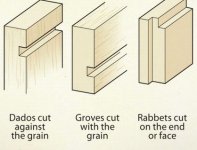I learned woodworking from books and magazines. Later from the Internet, but in the late 1970s that was not much used.
One book I read early on made a distinction between “dadoes” and “grooves”. I have always adhered to that distinction. But I am questioning it lately.
A dado ran across the grain, and a groove ran parallel to the grain. Plywood, MDF and particle board only had dadoes.
Is anyone still making that distinction? Sometimes I feel silly doing so.
One book I read early on made a distinction between “dadoes” and “grooves”. I have always adhered to that distinction. But I am questioning it lately.
A dado ran across the grain, and a groove ran parallel to the grain. Plywood, MDF and particle board only had dadoes.
Is anyone still making that distinction? Sometimes I feel silly doing so.

